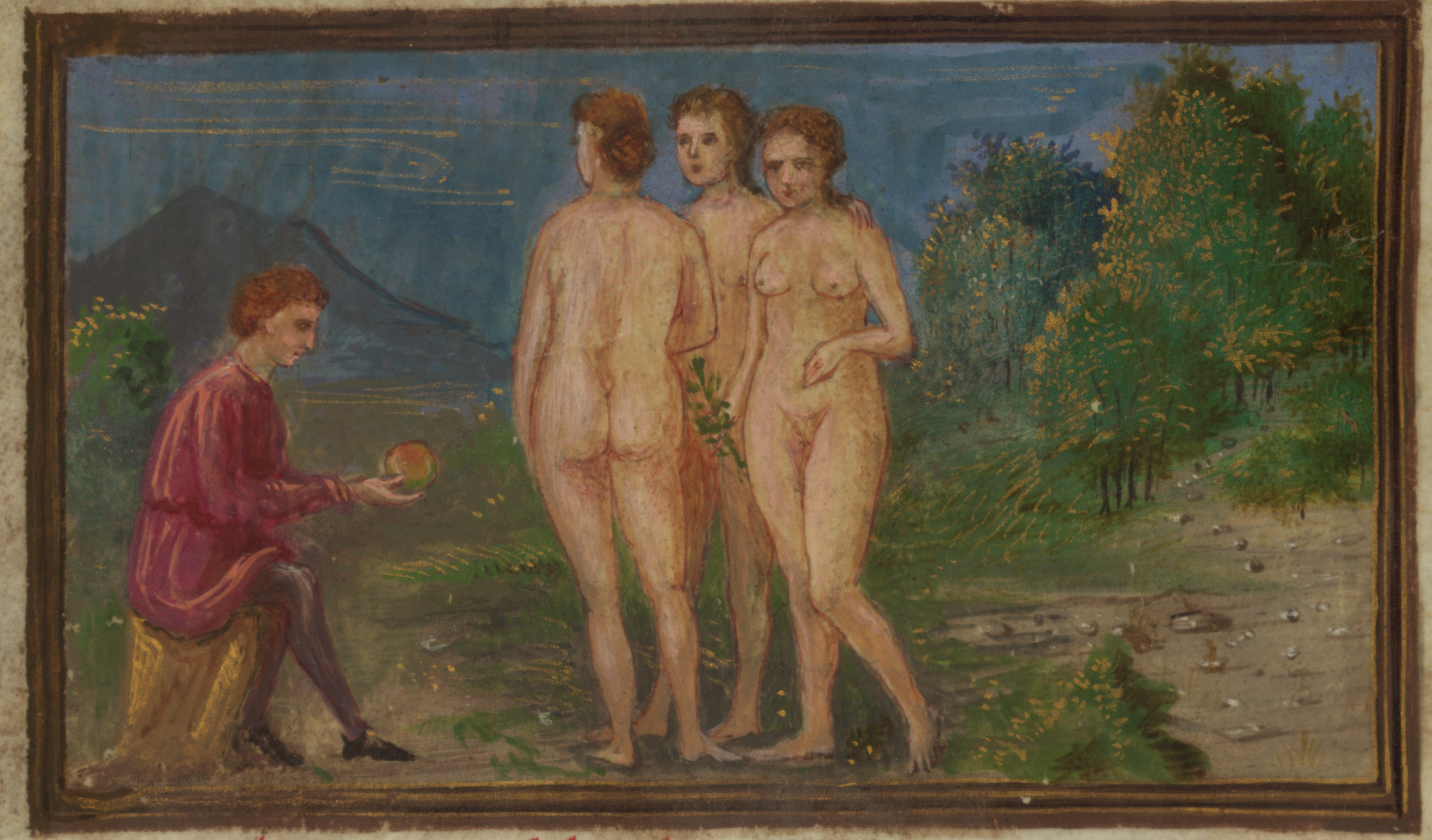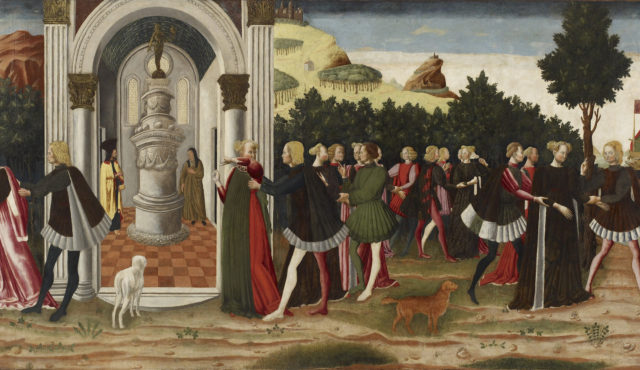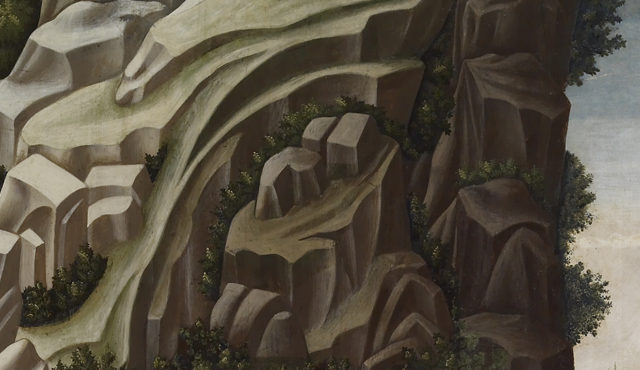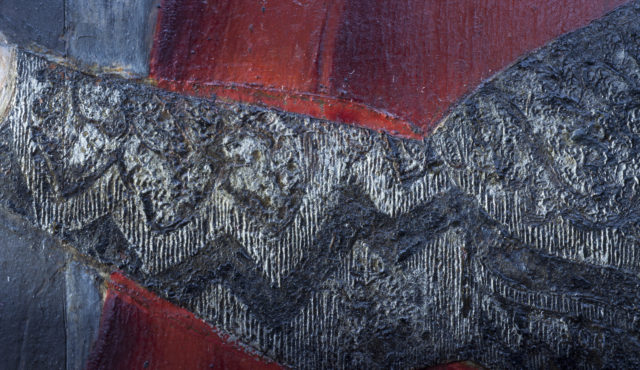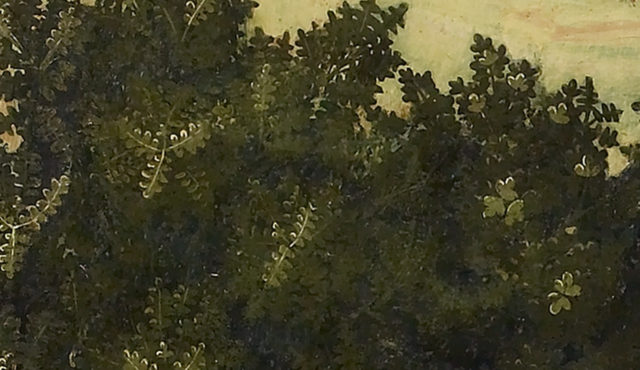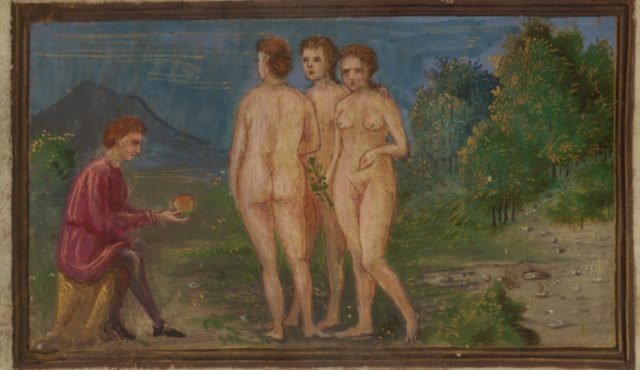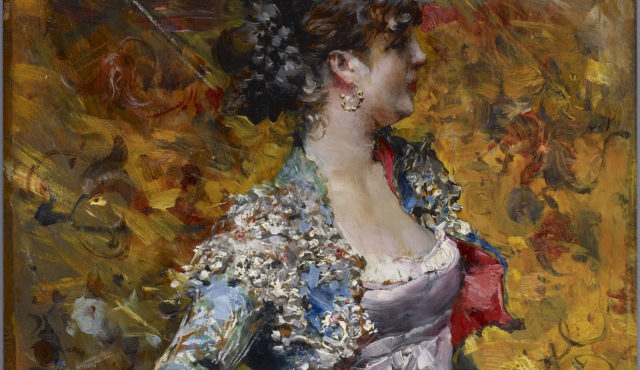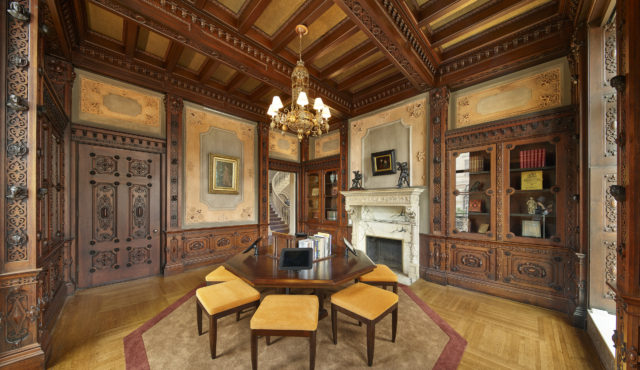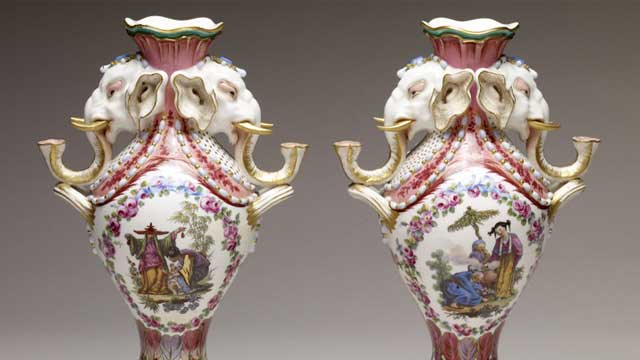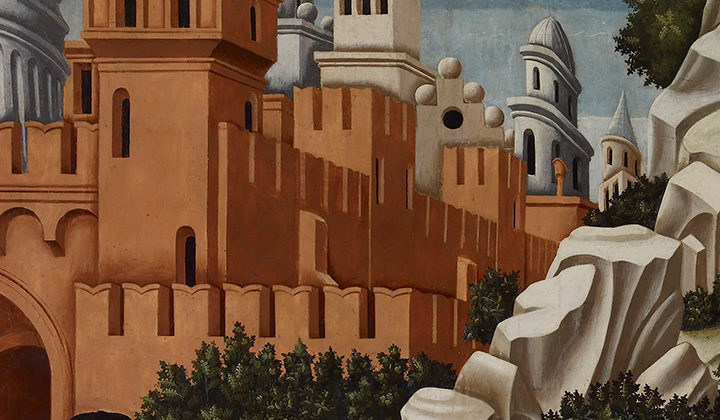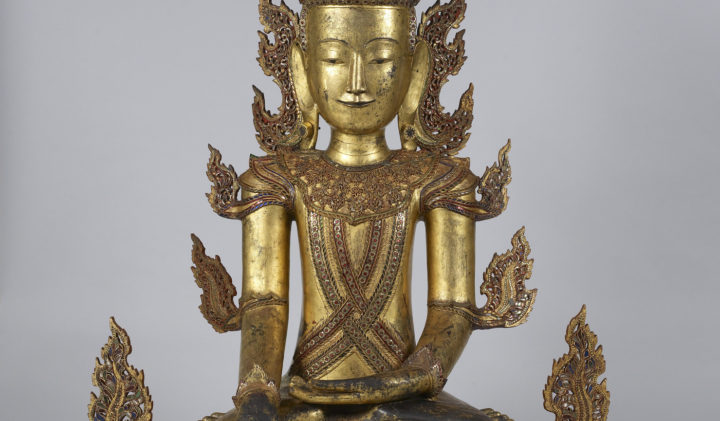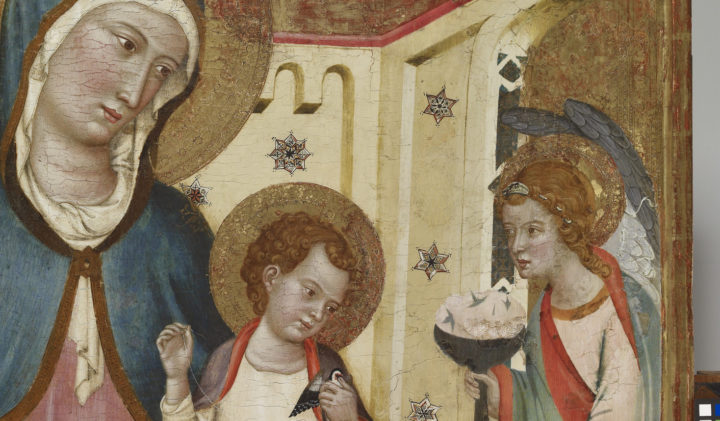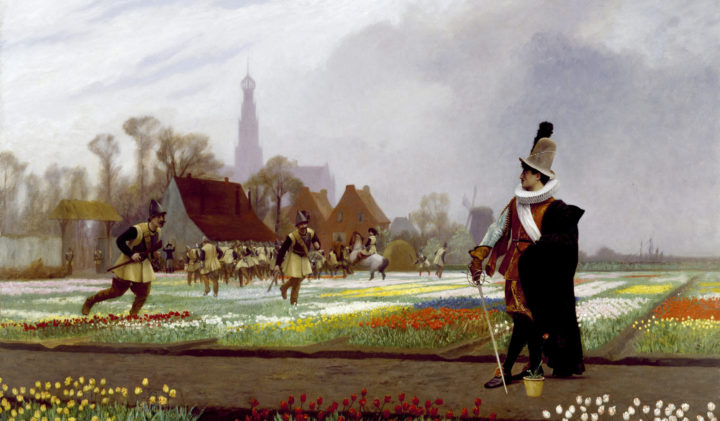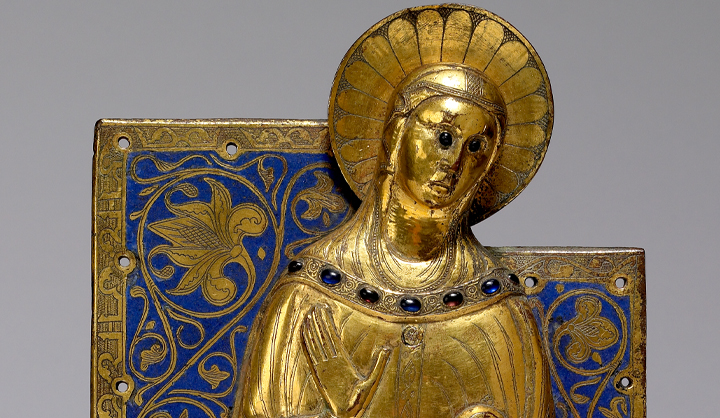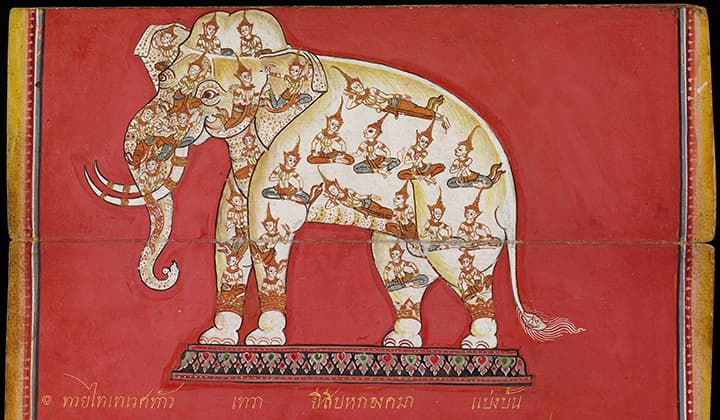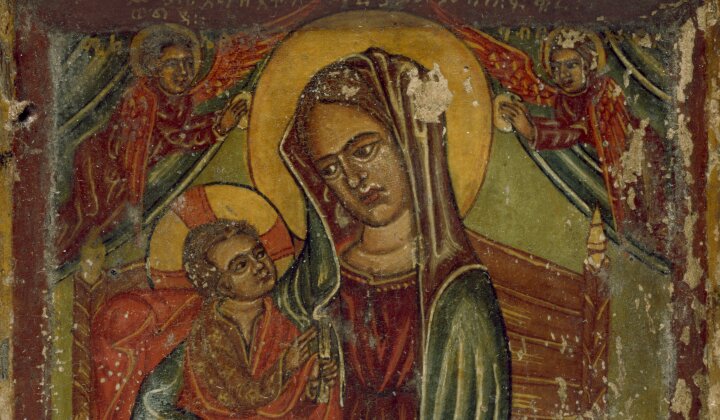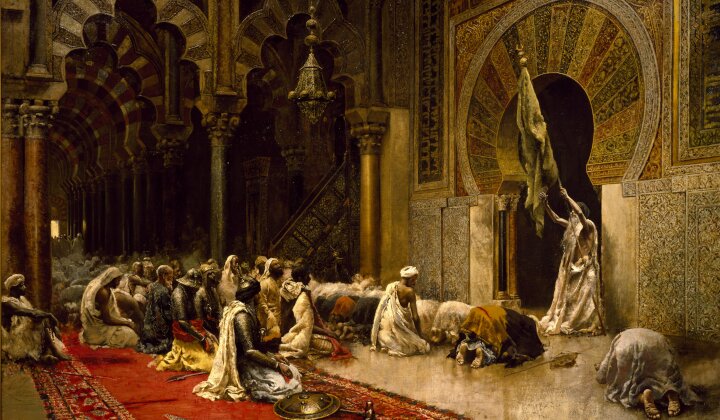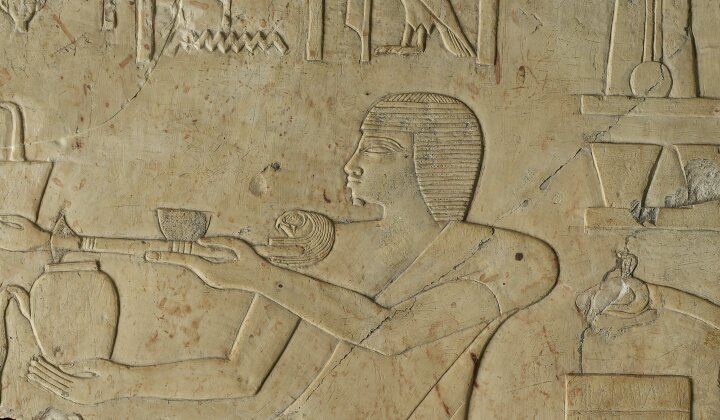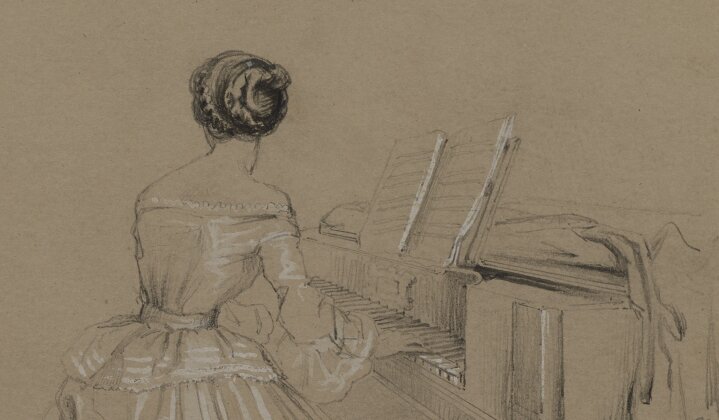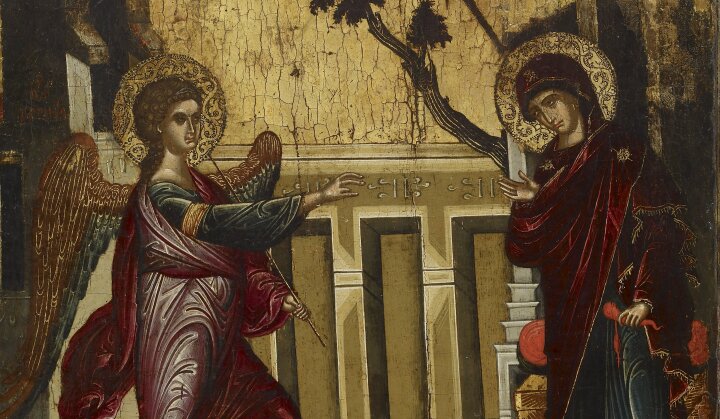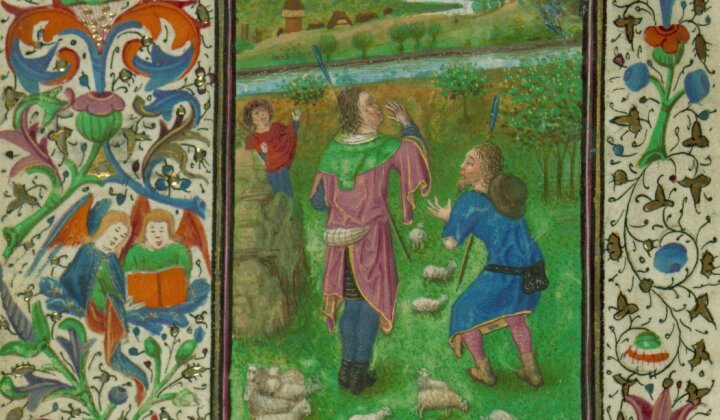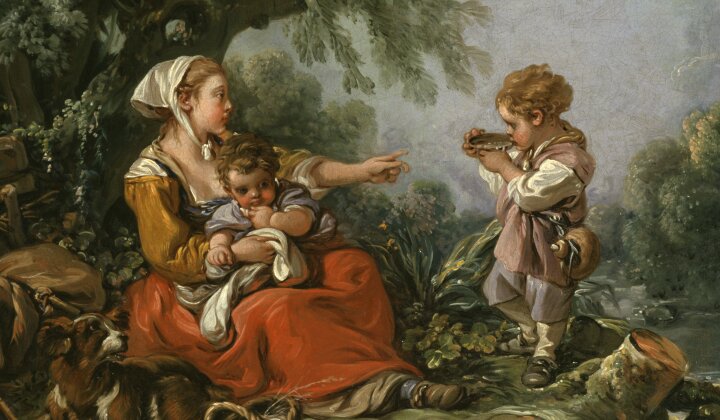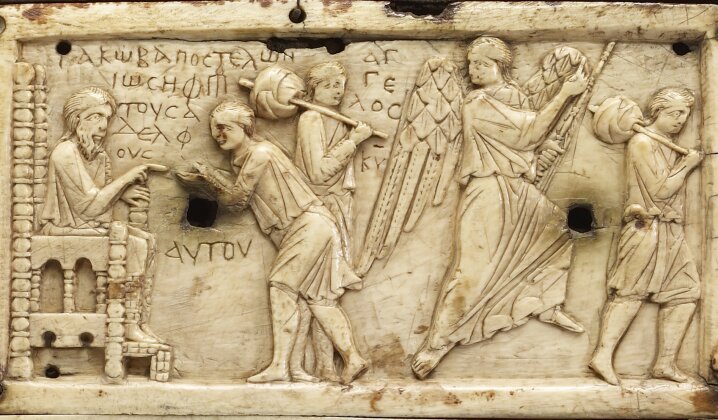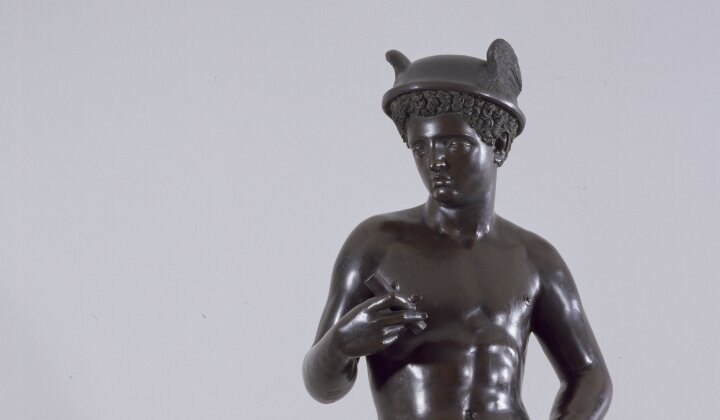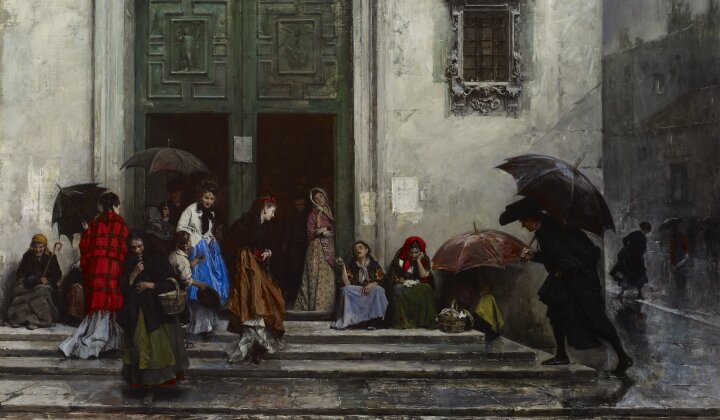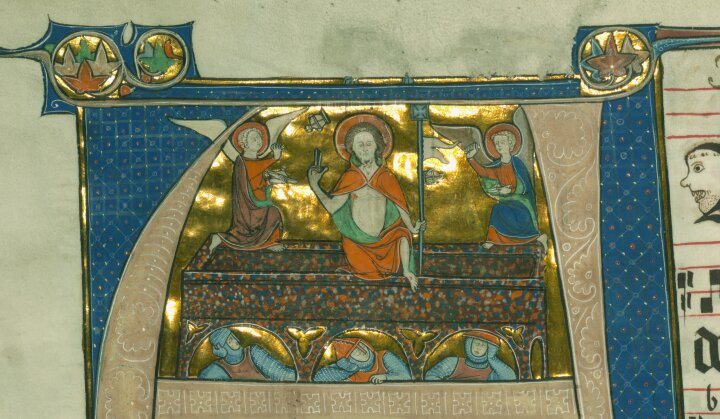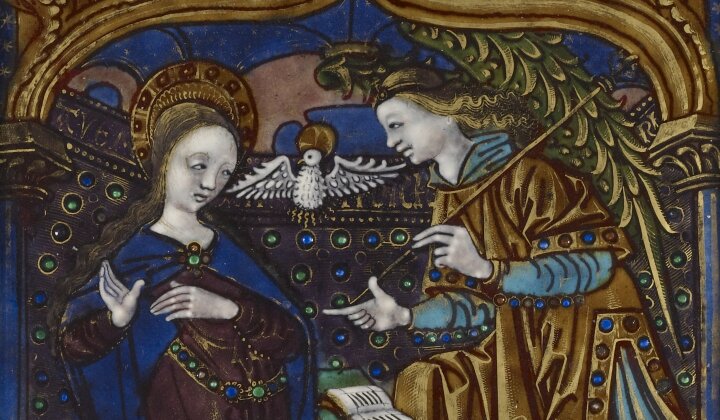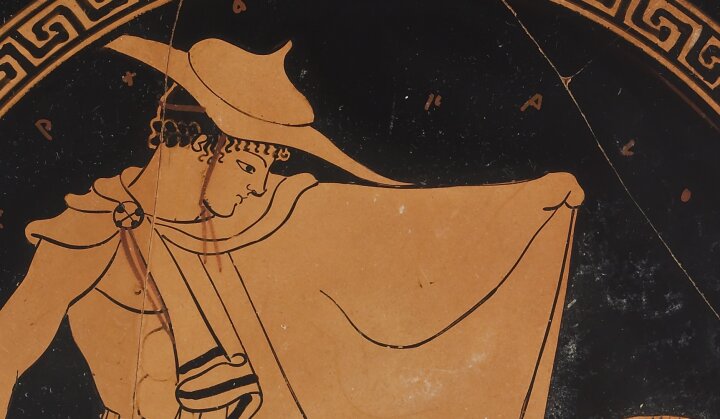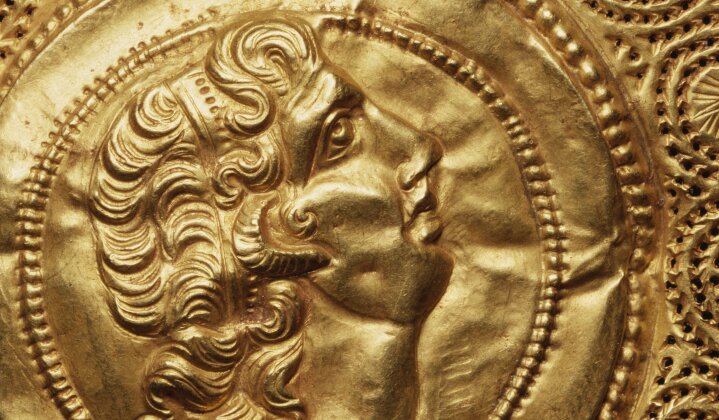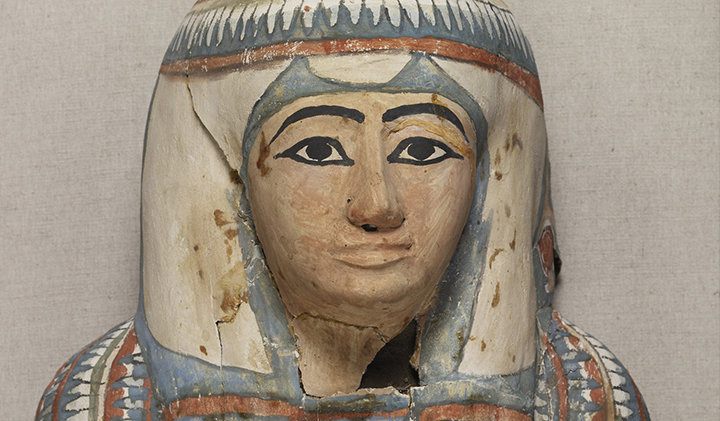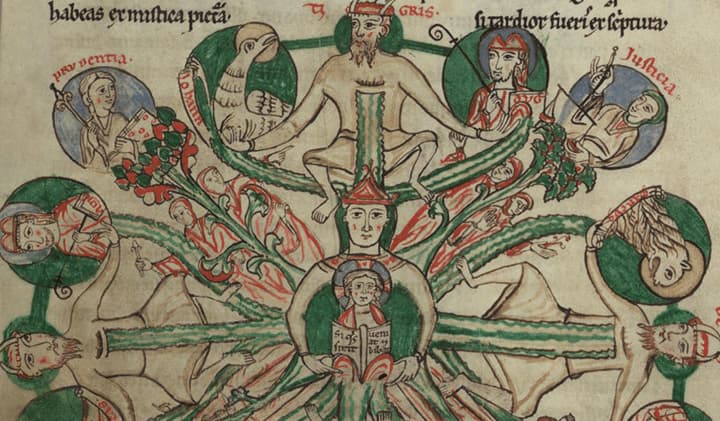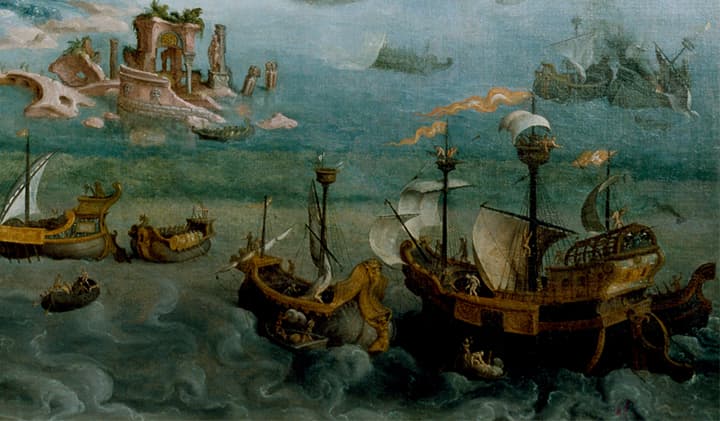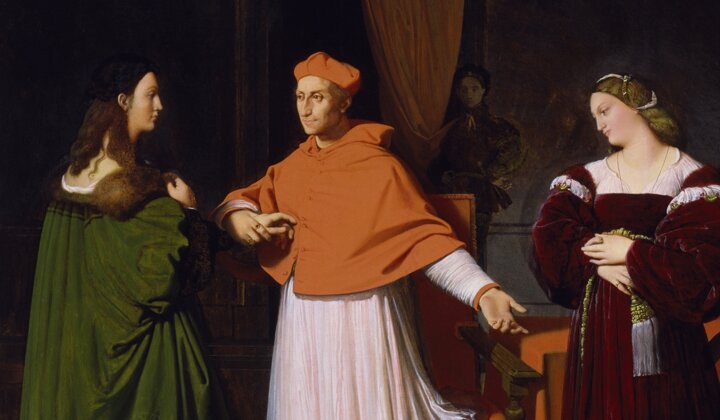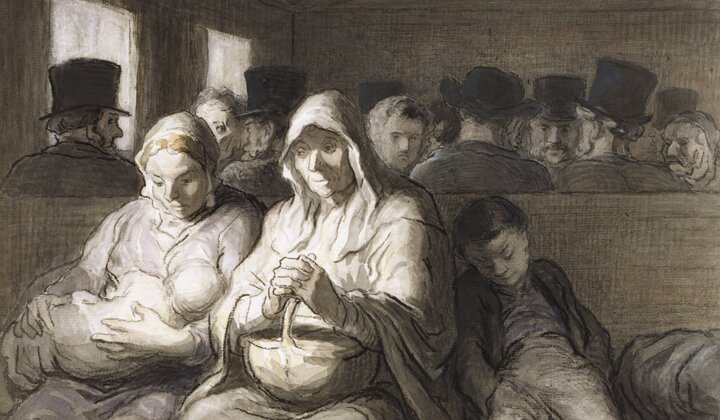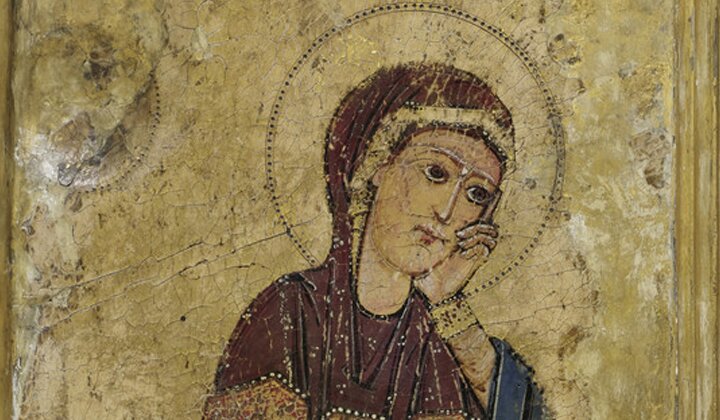Helen of Troy, featured in the Walters’ series of three Venetian fifteenth-century paintings representing The Abduction of Helen, is blond.[1] Ever since Homer’s description in the Iliad up to the medieval and Renaissance versions of the story that were the probable sources for the paintings, Helen has been described as blond, “fair-haired,” having “golden locks,” and many other variations.[2] Viewing these paintings in my capacity as a professional cosmetologist, I found it striking that all of Helen’s female attendants—indeed all the female members of the court in The Departure of Helen and Her Entourage for Cythera—are similarly blond (fig. 1). Why did Homer call Helen “fair-haired” unless this trait set her apart from others? However, this is not Homer’s ancient Greece but Quattrocento Venice.

Dario di Giovanni (ca. 1420–before 1498) and collaborators, The Departure of Helen and Her Entourage for Cythera (detail), ca. 1468. Tempera and Pressbrokat on spruce, 60 × 94 3/16 in (152.4 × 239.2 cm).
The Walters Art Museum, Baltimore, bequest of Henry Walters, 1931, acc. no. 37.1178
Natural blond hair in adulthood is rare, even in Europe, where the blond trait is endemic.[3] Roughly one in twenty European adults can grow hair as light as Helen and her companions (level 8 and lighter) as depicted in the three paintings.[4] Historically, more European blonds are born nearer to the Baltic Sea than to Venice, where the Abduction of Helen paintings were produced.[5] If these paintings were depictions of “real life,” in the sense of naturally occurring physical traits, rather than “idealized history,” Helen ought to be the only blond among a sea of darker heads—but she is not. The paucity of dark female heads in these paintings speaks volumes about what constituted ideal beauty in Renaissance Venice.
Medieval and Renaissance standards of beauty required women to possess two simple traits: golden hair and white skin. It was canonical in poetry for female love objects to be “gold and white,” and Francesco Petrarch’s poetic description (ca. 1327–1368) of Laura is a typical account of this desirable combination:
le bionde treccie sopra ‘l collo sciolte,
ov’ogni lacte perderia sua prova,
e le guancie ch’adorna un dolce foco.
Blond waves loose upon her neck,
where any milk would lose in competition,
and her cheeks adorned by a sweet fire.[6]
This beauty standard was accepted, even promoted, by the church, the state, and the medical community. Venetian artists often depicted golden hair and milky white skin on the female religious figures displayed in churches, such as representations of St. Catherine of Siena in Lorenzo Veneziano’s Betrothal of St. Catherine (1369, Accademia, Venice) or in Vittore Carpaccio’s Catherine of Alexandria and St. Veneranda (ca. 1500, Museo di Castelvecchio, Verona). The Republic of Venice used the image of a blond woman to personify the city. Golden-haired women were considered healthy, according to contemporary medical theories of the four humors, which involved ascertaining the correct balance of blood, yellow bile, black bile, and phlegm in the body. This balance would present itself through physical traits including hair color; golden hair along with “fleshiness, pallor, and docility” was thought to be a characteristic of phlegmatic persons, including most women.[7]
Contemporary sources demonstrate that Venetian women artificially lightened their hair, but they couldn’t just nip round to the drugstore and buy a box of Clairol: where did they turn for beauty information? A Treatise on Cosmetics (W. 478) in the Walters Art Museum dated around 1500 provides one answer.[8] Written in Venetian Italian, it is a compilation of recipes devoted entirely to female body care, beautification, and hair coloring. The treatise is the product of developments in two seemingly unrelated technical genres: the “popular” health guide and alchemy. These developments can be briefly outlined to understand the context of the Walters treatise.
Cosmetics in Health Text
In Europe, very little written cosmetic information survives from the sixth through the eleventh century.[9] But in the twelfth century, cosmetic recipes in Latin are recorded in medical manuscripts created for professionals. Eight recipes for making the hair “golden” are listed in De ornatu mulierum (On women’s cosmetics), the third chapter of a famous gynecology text written in Salerno and known as the Trotula.[10] Medieval doctors did not draw a sharp line between “cosmetics” (defined as substances which beautify but cannot cure), and “medicines” (which cure but do not necessarily beautify); cosmetic recipes could be used “therapeutically” in the belief that they would prevent, or remedy, bodily ills.[11]
In the thirteenth century, the Tacuinum Sanitatis, the first “popular” health manual designed for non-physicians, was translated into Latin from Arabic. It does not include hair-lightening recipes, but it marks the transfer of “secrets” previously reserved for professionals into the public domain. The Tacuinum Sanitatis condenses the Greek physician Galen’s (129–210 CE) humoral-based principles down to their bare essentials, creating an easy-to-follow, step-by-step plan for healthy living. Its simplicity suited the wants of Latin-reading (usually male) elites seeking practical advice without theoretical ramblings.[12] Tacuinum Sanitatis manuscripts were prestige objects and were often lavishly illuminated. [13]
By 1256 the Latin language barrier started to fall. Beatrice of Savoy, wife of Raymond Berengarius, count of Provence, commissioned their court physician, Aldobrandino of Siena, to write, in French, the Régime du Corps—an expanded compilation of passages lifted from Tacuinum Sanitatis and a variety of other medical sources, including Isaac Judaeus, Avicenna, Rhazes, Constantinus Africanus, and Ali Abbas. The Régime du Corps covers a wide array of topics including Galen’s precepts, information on the properties of seventy-three different foods, advice on pregnancy and the care of newborns, and a discussion of physiognomy and body care; a section devoted to hair includes a passage on hair lightening.[14]
By the end of the thirteenth century, more and more cosmetic recipes (in Latin) appeared in physicians’ and surgeons’ manuals, yet another indication of the porous boundary between the cosmetic and therapeutic.[15] Although these authors expressed reservations about the ethics of beautification, they took great pains to categorize and sort each treatment type, and they were keenly aware that cosmetic preparations could be a lucrative source of income for enterprising doctors.[16]
Medieval alchemists, the forebears of modern chemists, are best known for their pursuit of the Philosopher’s Stone, a substance purported to convert base metals into gold. While they ultimately failed in this quest, alchemists’ habits of empirical testing, patient observation, and their use of specialized equipment (for example, alembics), drove advances in many fields, including textile dyes, glass technology, medicines and cosmetics.[17] Many late medieval and Renaissance cosmetic and hair-care recipes rely on ingredients produced by distillation (for example, alcohol), and require alembic equipment to distill essential oils and hydrosols (for example, rose water (fig. 2).[18]
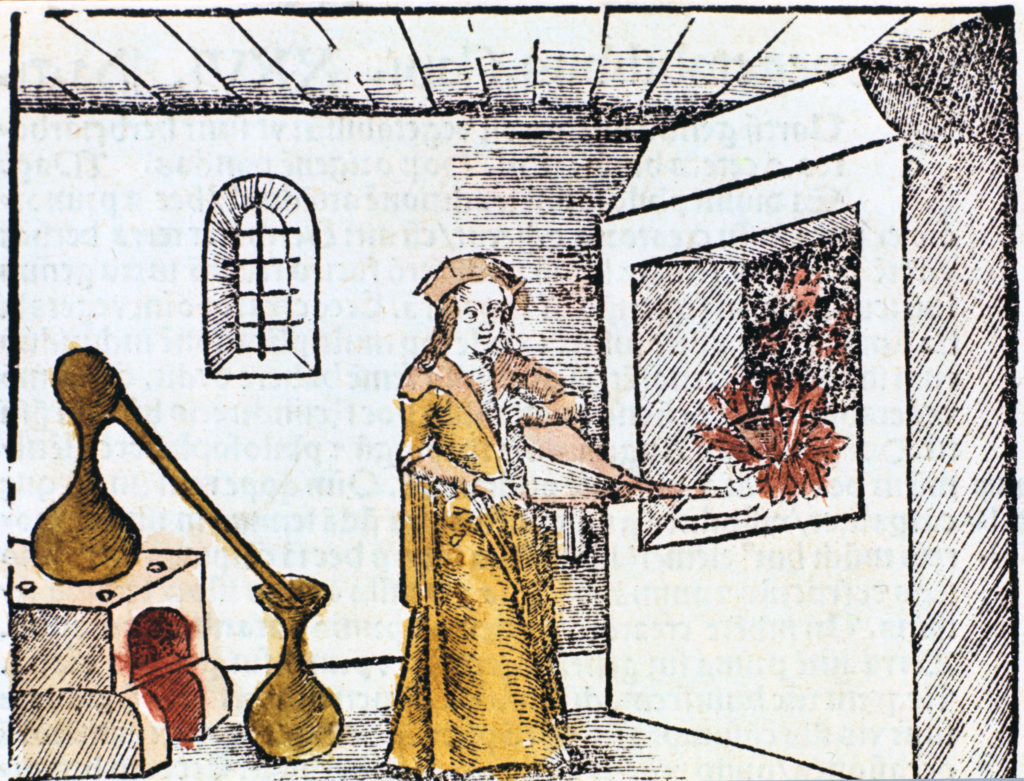
“A Chemist.” From Gregor Reisch, Margarita philosophica (The Pearl of Philosophy) (Basel, 1508). Photograph HIP/Art Resource, NY
Comparable Cosmetics Texts
Within this brief discussion, the Walters’ Treatise on Cosmetics can be usefully compared with other contemporaneous cosmetic manuscripts: the Experimenti compiled by Caterina Sforza (1463?–1509), Countess of Forli and Lady of Imola,[19]and the anonymous Ricettario Galante compiled between 1500 and 1520.[20]
The Experimenti is a wide-ranging compilation of more than four hundred recipes for “curing headache, fever, syphilis, and epilepsy; lightening the hair or improving the skin; treating infertility, making poisons and panaceas; and producing alchemical gems and gold.”[21] Many recipes require distillation, including two for blonding.[22] Sforza collected recipes from numerous correspondents over many years, which might account for the compilation’s haphazard organization. Recipes are composed in both Latin and Italian; Sforza ensured the secrecy of some recipes by writing them in code (it is therefore likely that only she could quickly locate specific items).[23] Ingredient quantities are often vague or even missing altogether, perhaps due to oversights by her correspondents.
Like the Experimenti, the Ricettario Galante is not exclusively devoted to beautification: it includes recipes for lactation disorders, plague prevention, cancer, burn care, pain relief, and antidotes for poison, but it does not include stereotypically “masculine” subjects such as metallurgy, alchemy, or invisible ink. The Ricettario Galante contains many recipes that require alembics. The recipes are grouped according to topic, but in the absence of the original manuscript, it is unclear whether Guarini’s transcript is faithful to the original in either the sequence or completeness of the recipes.
The Walters’ Treatise on Cosmetics is the most specialized of these three manuscripts and arguably the most optimistic regarding the vicissitudes of Renaissance life in Italy: there are no cures for plague, poison, syphilis, or even the common headache.[24] Even the “maternity” recipes assume mutual fertility, easy pregnancy, and safe delivery by addressing only the predictable consequences of the happy event: stretchmarks and loosened flesh.[25]
The Walters’ Treatise on Cosmetics is decorated throughout with marginal drawings of flowers and birds, as well as two illuminations, both alluding to Helen of Troy. The first, placed at the bottom of folio 4r, is an illuminated shield (fig. 3): truncated, gold with a black eagle, banded with gold and red. The shield is superimposed on crossed laurel branches and surrounded by the motto “GAUDE SORTE TVA” (“rejoice in your lot”). This quotation from Horace (Epodes 14.15) alludes to Helen of Troy; the poet compares a lover’s ardor to the fire that consumed Troy. The second illumination decorates folio 5v, the first page of recipes. The page is bordered by an elaborate frame of urns and flowers on a black ground. Inside the frame at the top is depicted the Judgment of Paris (fig. 4), the second allusion to Helen. The depiction of a coat of arms in the preface implies that it was commissioned by a father for a daughter’s wedding, or a by husband for his bride, rather than by the addressee for herself.[26] That a man would bestow such a gift implies that the recipient was expected to adhere to the beauty norms (implicit and explicit) in the recipes, and the choice to depict the “Judgment of Paris” drives home the fact that only the most beautiful woman wins.[27]

Illuminated Shield, from a Treatise on Cosmetics. Tempera on parchment. The Walters Art Museum, Baltimore, bequest of Henry Walters, W.478, fol. 4r (detail)
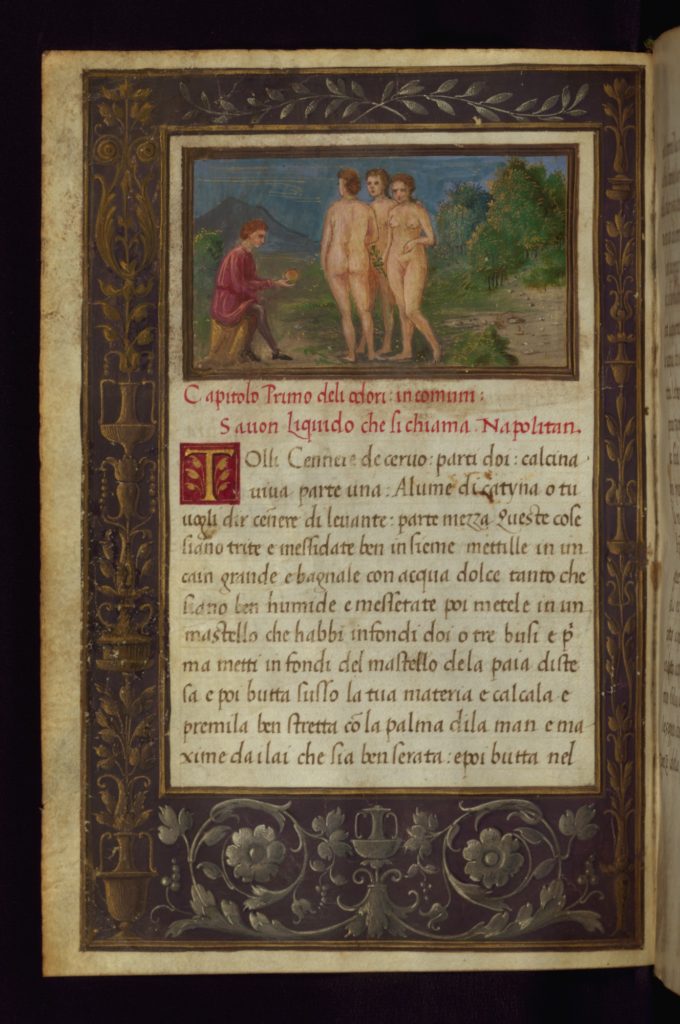
The Judgment of Paris, from a Treatise on Cosmetics. Tempera on parchment. The Walters Art Museum, Baltimore, bequest of Henry Walters, W.478, fol. 5v (detail)
Compared to the Experimenti, the Walters’ Treatise on Cosmetics is a marvel of organization, indicating that the work was carefully planned, edited, and designed. The recipes are written with black ink in a clear hand; all section and recipe titles are written in red ink, with the first letter of text under each section title illuminated and gilded, thereby making specific recipes easier to find.
Contents
The first text pages (fols. 2v–3v) are a table of contents including subject headings and recipes (grouped by classification); the table corresponds closely to the actual sequence of red-letter recipes but it is not exact. [28] The table is followed by a preface (called epylogo in the manuscript) directed at the volume’s unknown female addressee. It exhorts her, in flattering language, to use the recipes as a form of self-improvement through intellectual inquiry (fol. 4r). The text is divided into two chapters. The first, entitled de li odori: in communi (“on fragrances in general” [fol. 5v]), involves the concoction of soaps, fragrances, and common base mixtures used in later recipes. Chapter 2, titled di le cose preseratiue di la bellezza humana, É prima de I cauelli (“on the things preservative of human beauty, And first the hair” [fol. 24r]), is devoted to hair lightening, treating hair loss, and preserving and beautifying the eyes, teeth, gums, breath, and skin of the face and body. The recipes are remarkably detailed regarding ingredients, amounts, equipment, and procedures.[29]
A number of recipes in the Walters’ Treatise on Cosmetics can be found in antecedent, contemporary, and slightly later cosmetic texts.[30] For example, the Walters’ Treatise on Cosmetics and the Experimenti share a nearly identical recipe for hair regrowth (Treatise: fol. 26v/Experimenti: 654–55), and with Guarini’s Ricettario Galante, it shares recipes for remedying ruined teeth and gums (Treatise: fol. 29r/Guarini: 64), hair pomade made from “appiolan apples” (Treatise: fol. 11v/Guarini: 81), a potash water for lightening hair (Treatise: fol. 24r–v/Guarini: 42–43), and a hair preparation made from distilled honey (Treatise: fol. 26r–v/Guarini: 32). Unlike the Experimenti and the Ricettario Galante, however, the Walters’ Treatise on Cosmetics includes brief discussions of general principles governing each recipe class, which is helpful in orienting the reader to the material.
The beauty recipes of these three treatises assume that the addressee is wealthy: they are material- and equipment-intensive, calling for large amounts of wild and cultivated plant material,[31] and costly imported ingredients such as fragrant resins, spices, and sandalwood.[32] One needs scales to weigh ingredients, and a large variety of alembics and vessels, including wooden wash tubs, bottles, jars, flasks, buckets, cauldrons, new earthen bowls and basins (glazed and unglazed), mortars and pestles in ceramic, brass, porphyry and wood, porphyry plaques, fabric and sieves for filtering, and spoons, mashers, mullers, whisks, and stirrers.
Recipe Tests
I tested two of the eight hair-lightening recipes in the Walters’ Treatise on Cosmetics to experience what it was like to make them, and to compare their performance (see below). However, due to the functional difference between modern and Renaissance kitchens, I was forced to employ a number of anachronistic substitutions with ingredients, utensils, and measurement. Both recipes call for plant ash, but ash from ivy and grape vine was unavailable—so I burned charcoal briquettes instead.[33] For safety, I used modern pH testing strips to check solution strength. Renaissance weights and measures were calculated differently. There were twelve ounces to the Veneto pound, and the Venetian pound-equivalent could vary between 0.301 and 0.477 kilograms depending on context.[34] Using a digital scale to weigh ingredients, I settled on forty grams to the ounce to make calculations easier. Regarding liquid measurement, the Veneto “flask” was 0.979 liter (about a quart). [35] I used plastic bowls and buckets rather than ceramic or wood, and stainless steel boilers rather than ceramic or iron.
Kitchen Notes: Recipe A:
ON THINGS THAT PRESERVE HUMAN BEAUTY: AND FIRST, THE HAIR: One makes a marvelous potash water in this way: fennel, ivy leaves, sage, rosemary as much of one as the other—bear’s breech, three parts. Next put all these herbs in a cauldron full of sweet water, but I warn you that one must have these herbs in good quantity to make a lot of decoction. And boil the herbs until you have one third part of the water remaining. [Take] Ash of ivy and vines in good quantity and put them in a pointed sack, because it requires straining, and pour over [the ash] the above-mentioned water that you have cooked at your discretion and make the water pass and strain through the ash at least five times: always pouring it over hot (or make potash water in your own way with the aforementioned water and ash).[36]
In a pasta pot I boiled rainwater, ivy leaves, sage, and rosemary from my garden, skipping the fennel and bear’s breech, which I don’t grow. I decided arbitrarily to use three quarts of rain water since the quantity is unstated. It was a hot August day, so I simmered the herbs until I couldn’t bear the steamy heat any longer. I got 1.75 quarts of fragrant, tea-colored liquid.
Because the quantity of ash is unstated, I used the same amount asked for in Recipe B (i.e., 240 grams, see below). Since I was uncertain how to safely pour boiling water through a “pointed sack” I decided to make potash water in my “own way.” I enlisted the aid of a flower pot, filling it partially with pebbles. Instead of using a bag, I lined the flower pot with an old dish towel, keeping the ends hanging over the sides (these later became handles to lift out the remaining sludge). In a separate plastic bowl, I dampened the ash with a little herbal decoction, then spread it on the towel inside the pebble-lined flowerpot, tamping it down evenly.[37] I then set the flower pot on a raised, perforated support inside a pasta pot in order to catch the filtrate as it trickled through the drain hole (fig. 5).
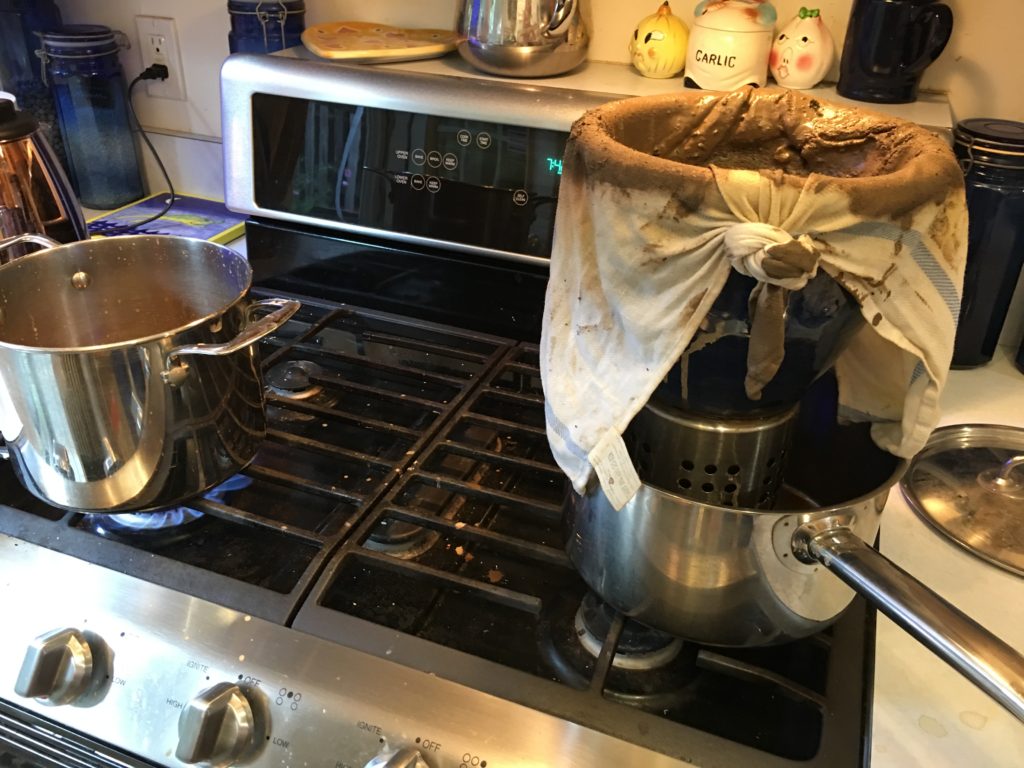
Recipe A: Filtering herbal decoction through ash. Photograph Janet Stephens.
I boiled the remaining decoction and poured it over the ash. The first filtration was a thin slurry, pH 9. I transferred the flower pot and support to another pasta pot, boiled the slurry and poured it over again: the second filtrate was pH 11. I retransferred and reboiled the mud five times as required. What an unholy mess! After the third filtering, the pH topped out at 12 (very alkaline, but safe to touch); filterings four and five were unnecessary except to make more mess and reduce yield. I funneled the final mud into a quart mason jar for settling. It was a tough job scrubbing out the flower and pasta pots, funnel and supports—ash residue is remarkably tenacious. The dish towel was stained beyond redemption. The mud took two days to settle and yielded about 0.56 liter (twenty ounces) of amber brown liquid with no discernible scent: I clearly didn’t boil enough herbs.
Kitchen Notes: Recipe B [fol. 26r]: Universal Rule of Blonds
Take alum chips, ginger, of each four ounces; ash, six ounces. Put in a good flask of water and bring it to a boil, then put it in the sun and leave it undisturbed for ten days: and when you have done that, wash your head with the sponge and comb.[38]
In a large stainless steel pot I combined 160 grams of powdered alum, 160 grams sliced fresh ginger,[39] 240 grams of ash and a quart of water—I was not expecting an exothermic chemical reaction! As I stirred, the ingredients spontaneously heated, bubbled and foamed, nearly breaching the top of the pot. After the bubbling settled down (being a literalist), I heated the pot on my gas stove until the contents came to a full boil. I let the mixture cool for several minutes before funneling the hot gingery muck into a half gallon mason jar to settle in the sun (loosely covered for five days), [40] and did the washing up. After decanting, yield was 0.448 liter (16 ounces) of lemonade-colored liquid with a pronounced gingery scent and pH of 6 (slightly acidic).
Application and Processing
I tested both recipes (fig. 6) on natural hair swatches taken from two individuals: “Maria” was a mixture of levels four and five (medium and light brown) and “Anna,” a mixture of levels six and seven (dark and medium blonde). I labeled the samples treated with Recipe A with blue elastics and Recipe B with white elastics. I fanned out the samples on a plastic surface, sponged them with decoction, and left them outdoors on a sunny balcony to dry, in adherence to the “general principles” of hair coloring: “blonds need to be done in the sun.”[41] Each sample was wetted and dried twice each day for eight days and exposed to as much as six hours of direct sunlight each day, weather permitting (fig. 7).
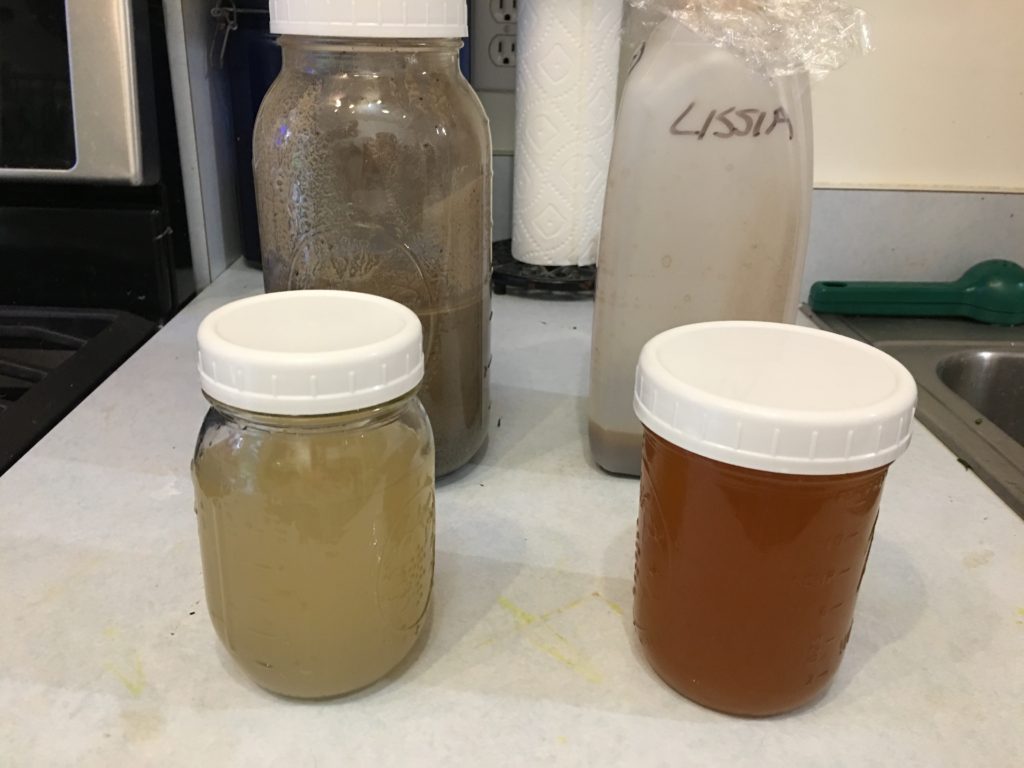
Finished decoctions, Recipe A (right), Recipe B (left). Photograph Janet Stephens
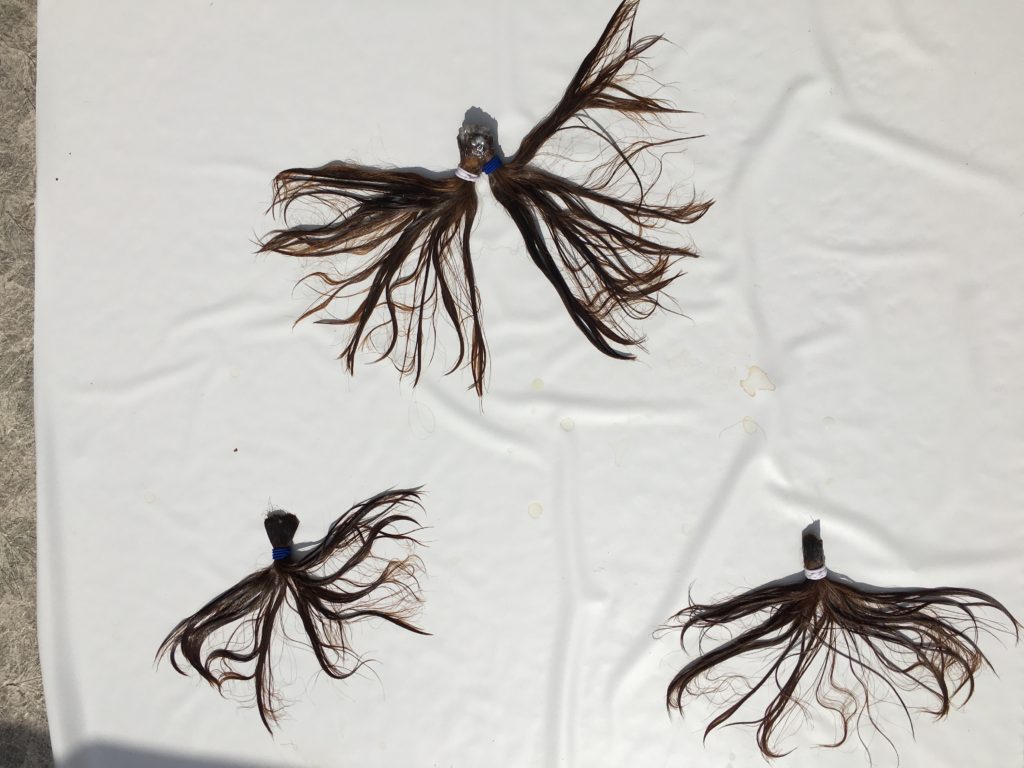
Hair samples drying in the sun. Photograph Janet Stephens
Sun exposure for blonding seems to have been a recent innovation: the Walters’ Treatise on Cosmetics and the Ricettario Galante both contain this instruction, but the Experimenti and earlier texts consulted for this study do not.[42] In theory, sunlight could boost the decoctions’ power (sunlight alone can lighten hair), but the practice is problematic because mid-day sun sabotages pale skin, by tanning (or burning) it. So what was a girl to do? The Walters’ Treatise on Cosmetics includes skin-whitening recipes to repair or conceal “damaged” skin,[43] but our lady might also have used a method described by Cesare Vecellio a hundred years later (fig. 8):
with much artifice and assiduously, all (or the majority of Venetian women), make their hair blond with diverse kinds of waters made for this purpose, and this they do at the height of the heat of the sun, enduring much for this effect. They sit with a small sponge tied to the top of a spindle and with it they bathe [their hair]. . . . and on their heads they wear [crownless] hats of fine straw that protect them from the sun; these are called “sun hats.”[44]
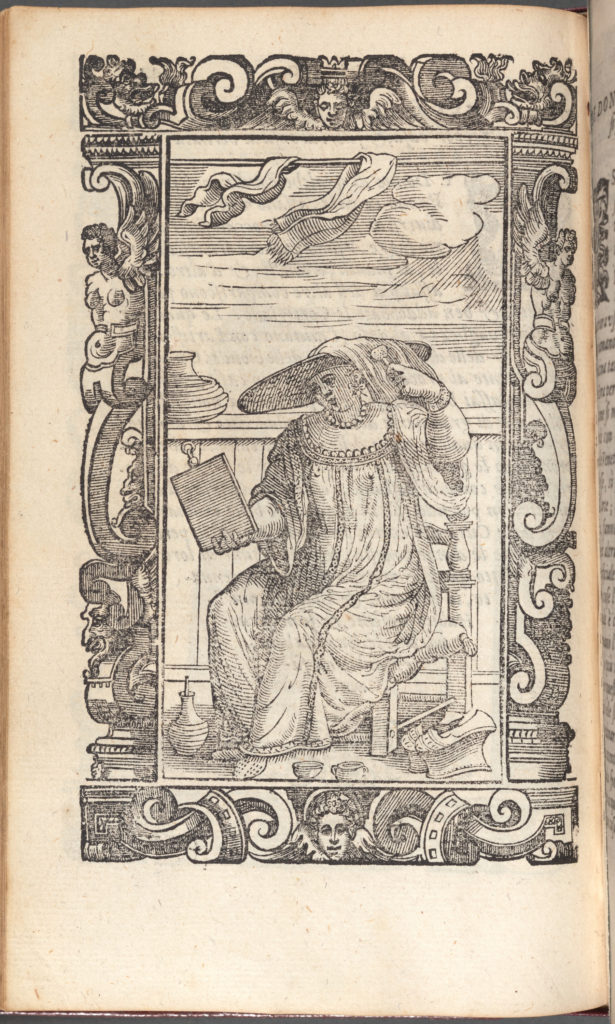
Fig. 8. “Altre donne di Venetia, mentre si fanno biondi I capelli.” [Other women of Venice, making their hair blond]. From Cesare Vecellio, De gli habiti antichi et moderni di diuerse parti del mondo [Of the ancient and modern clothing of different parts of the world] (Venice: Presso Damian Zennaro, 1590). New York Public Library, Spencer Coll. Ital. 590, fol. 144v. Photograph New York Public Library
Sun hats are not mentioned in the Walters’ Treatise on Cosmetics, but if our lady used one, it was still imperfect protection and awkward to use. The scalp at partlines and the forehead hairline would be exposed, risking sunburn with consequent pain, itching, and flaking skin while healing. The weight of wet hair on the brim would cause it to flex and slip, making the hat difficult to balance on the head, and gusts of wind might carry it off entirely. Moreover, the high mineral content of the decoctions made my hair samples difficult to comb while wet, and “crunchy” in texture after drying. This doubtless would have made sponging and combing while balancing the sunhat even more awkward.
Outcome
Recipe A shifted both samples one-half level lighter, and Recipe B, one level lighter (fig. 9). The results are most evident on the tips of the hair, where it was least compacted. While the change is barely noticeable on a gray scale, it is important tonally. When hair lightens, warm tones (i.e., red, orange, and yellow) automatically appear, making the hair seem more “golden,” the medieval and Renaissance ideal. Since Venetian women grew their hair long, the tips would be lighter from age, but also from years of overlapped potash water treatments and sunlight.
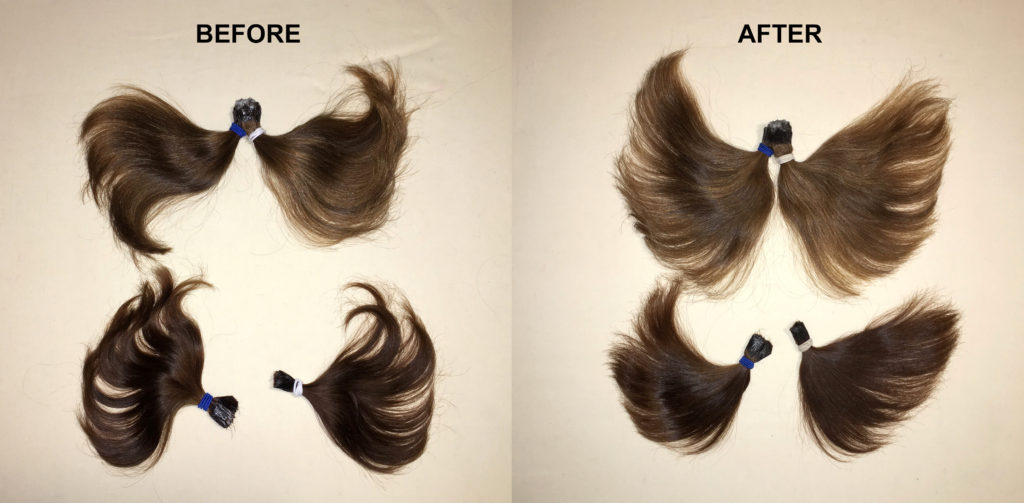
Hair samples, before (left) and after (right) treatment with recipes from W.478. Photograph Janet Stephens
Conclusion
Wealthy women in Renaissance Venice were prepared to expend much time, effort (their own and that of servants), money and expertise to achieve the beauty ideal of golden hair and white skin. Recipes for beauty aids were avidly collected and shared and can be traced through professional medical treatises, alchemical writing and “popular” health guides. Beauty recipes were considered an appropriate subject for illuminated manuscripts designed for female use, such as the Walters’ Treatise on Cosmetics.
Preparing hair lighteners was arduous, sloppy, and time-consuming for women in the 1400s. Using them was time consuming and uncomfortable, involving many days and long hours in the hot summer sun with tangly wet hair. Summer was the best and safest season for lightening one’s hair, given Venice’s clammy, foggy winters—consequently, three inches of roots might sprout between fall and late spring, when it was again safe to be outdoors with wet hair; dark roots are indeed evident in some sixteenth-century Venetian paintings, as noted by Jacqueline Spicer: “Palma Vecchio [ca. 1480–1528, Portrait of a Woman (Ufizzi, Florence, inv. 1890 no. 10094)] and Bernardino Licinio [ca. 1489–before 1565, Portrait of a Woman with a Book (Accademia, Venice)] had a penchant for portraying women with locks of bright golden hues, often with curious shading that suggest hair dye,”[45] and upon closer inspection, one can see slightly darker “hair” near the scalp on the women depicted in the Walters’ Abduction of Helen series (although this may be shading rather than evidence of hair bleaching).
Using sunlight to achieve the ideal of golden hair was at odds with the twin ideal of white skin. This drove innovation in headgear to protect the skin.
Even with their relatively detailed instructions, there is much latitude for misinterpretation and uncertainty in these cosmetic recipes. The author of the Walters’ Treatise on Cosmetics cautions the addressee that “it is necessary in all things to have prudence and ingenuity: potash waters and concoctions, in order for them to work, must be concocted beyond just their ‘cooking:’ they must be seasoned and proportioned, neither being too weak so that they don’t work, nor so strong that they destroy the scalp.”[46] Unstated, however, is the necessity of grit, patience and persistence: indeed, becoming “beautiful” was not for sissies.
Janet Stephens ([email protected])
is an independent scholar and professional cosmetologist.
My thanks to Elizabeth Archibald for bringing to my attention the crucial work of the Italian lexicographer Laura Ramello, and for her gracious assistance in deciphering obscure scribal abbreviations, to Joaneath Spicer for support, encouragement and valuable criticism, and to Lawrence Principe for his enthusiasm and reassuring explanations of the chemistry.
[1] The series comprises The Departure of Helen and Her Entourage for Cythera, The Abduction of Helen from Cythera, and The Reception of Helen at Troy, tempera and Pressbrokat on spruce. The Walters Art Museum, Baltimore, bequest of Henry Walters, acc. nos. 37.1178, 37.1179, and 37.1180 respectively. Another painting from the same commission, The Garden of Love (National Gallery of Victoria, Melbourne, Felton bequest, acc. no. 1827-4), depicts three blond women cavorting in a garden. For the Melbourne painting, see Spicer, “The Abduction of Helen,” in this volume.
[2]Homer Iliad, 3.328, 7.355, 8.81, 11.369, 11.505, and 13.766.
[3]Catherine A. Guenther et al., “A Molecular Basis for Classic Blond Hair Color in Europeans,” Nature Genetics 46, no. 7 (2014): 748–52.
[4]Cosmetologists measure the range of hair darkness on a ten-step grayscale (1: black, 2: very dark brown, 3: dark brown, 4: medium brown, 5: light brown, 6: dark blond, 7: medium blond, 8: light blond, 9: very light blond, 10: lightest blond). For statistics on the global geographical distribution of hair colors and levels in modern times, see Isabelle Lozano et al., “The Diversity of Human Hair Colour Assessed by Visual Scales and Instrumental Measurements: A Worldwide Survey,” International Journal of Cosmetic Science 39 no. 1 (2017):101–7.
[5]The uneven geographical distribution of natural blond hair in Europe has been noted since antiquity: Imperial Roman sources observed that comparatively lighter hair colors were characteristic of “northern” peoples; see Manilius, Astronomica 4.715; Martial, Epigrams 6.61.3; Juvenal, Satires 13.164–65; Procopius, History of the Wars 3.2. Twentieth-century physical anthropology maps support the conclusion that natural blond was, and remains, most common in northern Europe: Carleton S. Coon, Races of Europe (New York, 1939), 270–71 (Map 8).
[6] Franceso Petrarca, Canzoniere, 127.77–79 (author’s translation).
[7] On golden hair, see Jacqueline Spicer, “‘A Fare Bella’: The Visual and Material Culture of Cosmetics in Renaissance Italy (1450–1540)” (PhD. diss., University of Edinburgh, 2014), 33, 95. On skin and body type, see Visualizing Medieval Medicine and Natural History, 1200–1550, ed. Jean A. Givens, Karen M. Reeds, and Alain Touwaide (Hants, England, 2006),189.
[8] For a description and facsimile of the manuscript, see The Digital Walters and Laura Ramello, “La ‘cosmetica’ del ms. W 478 della Walters Art Gallery di Baltimora e la tradizione secretistica: Edizione e indagine lessicale,” in Bollettino dell’atlante linguistico italiano, 21 (1997): 185–246. Ramello includes a full edited transcript of the Walters’ Treatise on Cosmetics text, a large glossary explaining the often obscure terminology employed in the text, and a discussion of the recipes that the Walters’ Treatise shares with other cosmetic and medical texts.
[9] Laurence Moulinier-Brogi, “Esthétique et soins du corps dans les traités médicaux latins à la fin du Moyen Âge,” Medievale 46 (2004): 55–72 at 56.
[10] Monica Green, ed. and trans. The Trotula (Philadelphia, 2001): recipes 247, 254, 255, 260, 261, 265, and 266.
[11] Spicer, “A Fare Bella,” 14–15, 95, 99, 101–2.
[12] Cathleen Hoeniger, “Illuminated Tacuinum ‘Sanitatis Manuscripts’ from Northern Italy ca. 1380–1400: Sources, Patrons and the Creation of a New Pictorial Genre,” in Givens, Reeds and Touwaide, Visualizing Medieval Medicine, 53.
[13] A Feast for the Senses: Art and Experience in Medieval Europe, ed. Martina Bagnoli, exh. cat. Baltimore, The Walters Art Museum (New Haven and London, 2016), 207.
[14] Aldobrandino’s hair-lightening tips call for potash water (lessive: 2.1.14-15). For a page from part 2.1, see Bagnoli, A Feast for the Senses, 205. The full text of the treatise has been published by the Repertorio Informatizzato Antica Letteratura Franco-Italiana.
[5] Moulinier-Brogi, “Esthétique et soins du corps,” 58–61.
[16] Moulinier-Brogi, “Esthétique et soins du corps,” 63–64, 67.
[17] Lawrence Principe, The Secrets of Alchemy (Chicago and London, 2013), 135, 208.
[18] For a thorough introduction to small-scale fragrance distilling, see Bettina Malle and Helge Schmickl, The Essential Oil Maker’s Handbook: Extracting, Distilling and Enjoying Plant Essences (Austin, 2015).
[19] Pier Desiderio Pasolini’s transcription is based on a previous transcription; the whereabouts of the original are unknown. Pier Desiderio Pasolini, Caterina Sforza, 3: Documenti (Rome, 1893): 614 ff.
[20] Olindo Guerrini dates the source manuscript based on textual references to “living” persons. See Olindo Guerrini, ed., Ricettario galante del principio del secolo XVI (Bologna, 1883): iii–v.
[21] Meredith K. Ray, Daughters of Alchemy: Women and Scientific Culture in Early Modern Italy (Cambridge and London, 2015): 10.
[22] Pasolini, Caterina Sforza: 658, 692.
[23] Pasolini, Caterina Sforza: 615.
[24] The treatise includes a pomander recipe against “pestilential air.” See the Treatise on Cosmetics, W.478, fol. 42r.
[25] Treatise on Cosmetics, W.478, fol. 40r–v.
[26] As was the case for some books of hours; see Jonathan J.G. Alexander, “Women and the Italian Renaissance Illuminated Manuscript,” in Thresholds of Medieval Visual Culture: Liminal Spaces, ed.Elena Gertsman and Jill Stevenson (Woodbridge, Suffolk, 2012), 165–66.
[27] For the Judgment of Paris as a dream sequence that served as a prequel to the Abduction of Helen, see Spicer, “The Abduction of Helen” in this volume.
[28] Following the table of contents’ title, Astrenzer altri luochi, are six additional titles (unrelated to adornment) with no corresponding text in the manuscript. Also, the epylogo mentions a nonexistent afterword on “miraculous” subjects. Treatise on Cosmetics, W.478, fols.3v, 5r.
[29] Unlike “pure” alchemical literature, which was intentionally obscure. See Principe, The Secrets of Alchemy: 116.
[30] Besides the following cited recipe examples shared with Experimenti and Ricettario Galante, there are others to be found in the Trotula, the Régime du corps, the Experimenti, Cosmetica in ottave volgari del tardo Quattrocento, and the Notandissimi segreti de l’arte profumatoria by Giovanventura Rosetti (1555).For full details, see Ramello, “La ‘cosmetica’ del ms. W 478 della Walters Art Gallery, 185–99.
[31] For example, Caterina Sforza kept medicinal gardens in both Imola and Forlì. Ray, Daughters of Alchemy, 18.
[32] For example, upon her death, Caterina Sforza owed 587 florins to her speziale, Ludovico Albertini. Ray, Daughters of Alchemy, 27.
[33] It took four days to safely burn, cool, and transfer briquette ash to a covered metal container for eventual use.
[34] Ronald Zupko, Italian Weights and Measures from the Middle Ages to the Nineteenth Century (Philadelphia, 1981), 134, s.v. libbra.
[35] Zupko, Italian Weights and Measures, 125, s.v. inguistara. The Walters’ Treatise on Cosmetics contains the variant spellings ingistana, inghistana, and in gistara.
[36] Treatise on Cosmetics, W.478, fol. 24r–v (author’s translation). A nearly identical recipe is in Guerrini, Ricettario galante, 41–42.
[37]The recipe for Neapolitan soap calls for a perforated washtub to be prepared with a thick layer of straw at the bottom to support pre-wetted and tamped-down ash. Treatise on Cosmetics, W.478, fols. 5v–6r.
[38] Author’s translation.
[39] An attempt with ash and dried ginger absorbed all the liquid.
[40] I chose to cut it off because the exothermic reaction had finished by the second day and the pH did not change.
[41] “le bionde bisogna siano ben confetate al sole.”Treatise on Cosmetics, W.478, fols. 27v–28r, and Guerrini, Ricettario galante: 38, 49.
[42]Trotula, Régime du Corps and Petrus Hispanus’s (fl. thirteenth century) Thesaurus Pauperum (1626). Moulinier-Brogi, “Esthétique et soins du corps,” does not mention sunlight.
[43] Some contained toxic white lead and mercury. See the Treatise on Cosmetics, W.478, fols. 37r–38r.
[44] Passage from Altre donne di Venetia, mentre si fanno biondi i capelli (author’s translation); Cesare Vecellio, De gli habiti antichi et moderni di diuerse parti del mondo (Venice, 1589), 113 (author’s translation).
[45] Spicer, “A Fare Bella,” 212–13, figs. 34, 35, 36.
[46] “Bisogna in tutte le cose haver discretion e inzegno: le lessie e decoctioni che se debiono operare vogliono esser in tal modo condocte che oltra al debito modo di cocere vogliono esser ben stasona e temperate che per esser tropo dolci non fariano opera e per esser troppo forti si guastariano la pelle del capo.” Treatise on Cosmetics, fols. 27v–28r (author’s translation).
